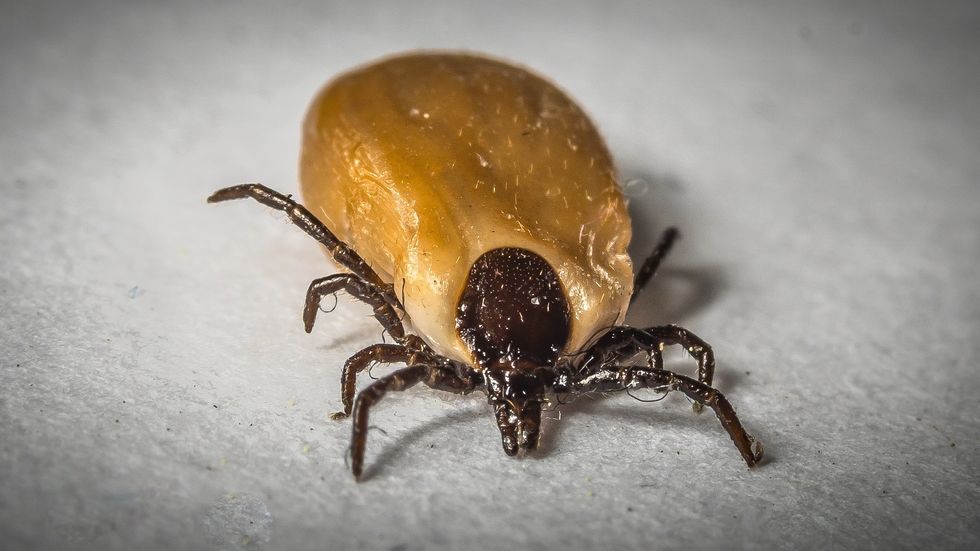The middle of winter may seem like an odd time to write an article about tick-borne illness: after all, the "season" for these notorious arthropods doesn't start until spring. However, with our rapidly changing climate (Bouchard) and sometimes reckless interactions with wildlife (Friend), the ranges for ticks, their animal hosts, and the diseases they carry promise to expand to new locales and pose novel public health challenges. It's never too early to start analyzing the pathogens that increasingly broad swaths of the population may have to cope with in the coming decades.
Alpha-Gal Allergy
As someone who has a rather more conventional allergic condition, the severe reactions to red meat that have become more common in certain regions of the United States constitute a baffling phenomenon. For one, the allergen in this case happens to be a sugar (alpha-gal) instead of a protein (Commins). This lends the condition some of its unusual features: most notably, a delay of several hours before the onset of symptoms (while a typical anaphylactic reaction would start within minutes) (Commins). However, the most surprising aspect of this allergy lies not in its manifestation, but in its apparent cause: tick bites (Commins). Though the exact mechanisms and species that cause this condition remain largely undetermined, researchers suspect that this may be yet another risk for humans interacting with environments where ticks are abundant.
Tularemia
Francisella tularensis stands out from the other tick-borne pathogens described in this article due to its massive range of potential hosts, variable clinical manifestations, and myriad transmission mechanisms. Though its presence in the wild and transfer to humans typically involves rabbits and small rodents fed upon by ticks and other arthropod vectors, F. tularensis infection has been observed in hosts as wide-ranging as sheep, cats, dogs, birds, frogs, snails, and fairy shrimp, among others (Friend). Ticks have been demonstrated as crucial reservoirs for the disease in the wild and are frequently implicated in human cases of tularemia, but the bacterium can also be spread through vectors such as mosquitoes and deer-flies, by handling animals with the disease, by consuming water in which F. tularensis is present, and, in certain cases, by inhaling particles traveling through the air (Friend). This versatility and the severity of the pulmonary, typhoidal, and septic forms of the disease has earned tularemia a place among the Category A potential bioterrorism agents identified by the CDC. Most people who contract the disease through tick bites end up with the less harmful ulceroglandular form, which, though capable of moving to the lymphatic system and producing much more serious symptoms in major organs, primarily consists of an uncomfortable skin lesion that morphs into an ulcer at the site of attachment (Friend). Survival rates for this illness have improved significantly due to antibiotics (Friend).
Rocky Mountain Spotted Fever
Of the tick-borne bacteria on this list, Rickettsia rickettsii stands out as a particularly unpleasant pathogen. Prior to the identification of effective antibiotic treatment, up to a quarter of people who contracted this disease died, often in less than two weeks after symptoms appeared (Harvard Health Publishing). Modern patients typically recover after approximately 5-7 days on a course of doxycycline, but potentially fatal complications can arise if medical professionals fail to identify the disease early (Harvard Health Publishing). As R. rickettsii carries out its assault against the interiors of veins and arteries, the victim develops a high fever and can experience head pain and gastrointestinal discomfort (Harvard Health Publishing). Later in the course of the disease, a rash develops on the limbs and gradually expands upward toward the torso (Harvard Health Publishing). Internal bleeding caused by vessel damage can result in renal failure and leakage of fluid into the lungs, obstructing breathing; in other cases, the bacterium can infect brain tissue, resulting in inflammation and producing neurological symptoms ranging from fatigue to coma (Harvard Health Publishing). Though many patients don't remember being bitten prior to contracting Rocky Mountain spotted fever, one should keep an eye out for the symptoms above upon finding a dog or Rocky Mountain wood tick embedded in their skin (Harvard Health Publishing).
Babesiosis
Though the deer tick may be most famous for spreading Lyme disease, it also serves as a vector for the protists that cause human babesiosis. Several parasites in the Babesia genus have been shown to produce this infection in humans, but Babesia microti remains the primary culprit in the United States (Vannier et al.) Tick larvae that feed on the white-footed mouse take up the pathogen with their meal; then, upon reaching the nymph or adult stage, they bite humans and transfer the parasite into the bloodstream (Vannier et al.) There, the parasite infiltrates human blood cells, where it undergoes cell division (Vannier et al.) After a certain number of replications, Babesia destroys the cell so that the newly formed parasites can enter other erythrocytes (Vannier et al.) This process generally results in a relatively mild disease with signs and symptoms often associated with viral illness, such as recurring fevers, exhaustion, pain in the joints and muscles, coughing, and loss of appetite (Vannier et al.) However, particularly in patients with weakened immune systems, the infection can take a more serious turn and result in deadly organ failures (most frequently in the lungs), making it particularly important for such individuals to take precautions against tick bites (Vannier et al.)
Human Granulocytic Anaplasmosis
Anaplasma phagocytophilium shares even more commonalities with the pathogen that causes Lyme disease: not only are they both bacteria, but A. phagocytophilium also typically enters the body via the bite of an infected deer tick - in fact, one can contract both Lyme disease and HGA simultaneously (Bakken and Dumler). Unfortunately, HGA tends to be more challenging to identify in patients due to its relatively vague set of signs and symptoms, which, much like babesiosis, resemble viral infections with manifestations such as high body temperature and various aches and pains, particularly in the head, muscles and joints (Bakken and Dumler). The patient outcome tends to be relatively positive, as most of those who contract the illness either recover on their own or respond favorably to antibiotic treatment; however, severe complications such as sepsis, heart inflammation, ARDS, and infections with other agents that take advantage of the body's weakened immune system can prove fatal in some cases (Bakken and Dumler).
Borrelia miyamotoi Disease
Though may tick-borne illnesses can be misdiagnosed as Lyme disease, Borrelia miyamotoi has proven particularly difficult to distinguish from atypical infections caused by its more notorious bacterial relative (Telfort et al.) In fact, until 2011, researchers who observed the pathogen's presence in "hard" ticks (like deer ticks) assumed that the arthropods were merely its hosts and did not serve as vectors for any sort of B. miyamotoi-related illness (Telfort et al.) Upon further investigation, B. miyamotoi's role in human disease became more fully elucidated, and some scientists now suspect that the resulting infection has long been misidentified in regions where Lyme disease is common (Telfort et al.) Both bacteria can be successfully treated with the same family of antibiotics, but key differences exist in when transmission proves most effective (B. miyamotoi seems to be spread largely by larval rather than nymphal ticks, meaning that the resulting illness tends to manifest in late rather than early summer) and what sort of symptoms patients experience (B. miyamotoi infections produce symptoms like fever and head pain more frequently than does Lyme disease) (Telfort et al.) As we get better at identifying these and other pathogens in the Borrelia genus, our understanding of these bacterial relatives - both well-known and obscure - is bound to improve.
Lyme Disease
At last, we arrive at one of the most notorious tick-borne pathogens in the United States: Borrelia burgdorferi, the causative agent of Lyme disease. Bites from infected deer ticks and western black-legged ticks can result in three successive phases of illness, starting with the classic rash (known as erythema migrans) that typically appears between 3 and 30 days after initial exposure (Shapiro.) Despite widespread warnings about the dreaded "bull's eye" shape, erythema migrans can also manifest as more uniform patches of redness and is primarily distinguished from other rashes by the speed by which grows to its final size on the patient (Shapiro). Some individuals (10%) never show signs of this rash or fail to recognize a bite (Shapiro), which can make later stages of the disease more difficult to diagnose.
The second phase may take the form of several (generally smaller) erythema migrans emerging on the skin and include paralysis of various nerves that control muscles around the face; general discomfort in the muscles, head, and joints; fever; extreme tiredness; meningitis; and inflammation of the heart (Shapiro). If left untreated, the condition finally develops into a final stage distinguished by painful joint inflammation (Shapiro).
Public awareness of the disease remains relatively high; however, its infamy can prove to be a double-edged sword (Shapiro). Though serious complications such as peripheral nerve damage and swelling of the brain can arise in various stages of the disease, they tend to be relatively rare, and several different kinds of antibiotics can be used to treat the illness effectively (Shapiro). Unfortunately, because of widespread panic over Borrelia burgdorferi and the high probability for false positives in tests for detecting the pathogen and associated antibodies, misdiagnosis and misinformation abound, particularly about conditions such as "chronic Lyme disease" that remain both poorly defined and sparsely documented in scientific literature (Lantos). Most cases in which symptoms of B. burgdorferi infection persist in this fashion can be attributed to other illnesses that are incorrectly identified and thus do not respond well to treatment (Lantos).






























